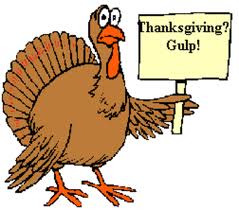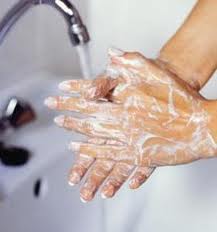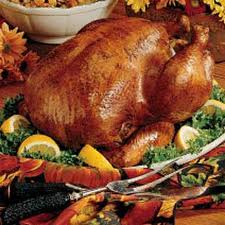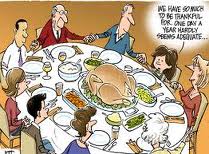Thanksgiving, my favorite time of the year. With the joy that I have for cooking on this holiday, I bring you: Chef Paul’s Thanksgiving Do’s & Dont’s, and general information on Turkey Preparation to help you cook a yummy and safe dinner.
It’s that time of year…the leaves changing colors, the temperatures dropping to allow for sweaters or light jackets, and an array of fruits and vegetables coming into season that just scream “autumn!” The flavors of acorn, butternut and pumpkin squash, sweet potatoes, parsnips, and the spices of cinnamon, nutmeg, and allspice…YUM! Little speaks more to autumn than my favorite holiday to cook for…THANKSGIVING! It’s a wonderful time to create and envelope your home with these wonderful flavors.
The day is filled with cooking, eating, libation, football, family & friends; I cannot think of a better way to spend the day!  I start out my day by washing the bird and patting it dry. I open up a bottle of champagne and take a drink. I prep all of the ingredients for the stuffing, cook and let it cool, then stuff the bird. I take a drink, wash my hands and pour myself another. I lay pats of butter and fresh herbs under the skin, season with kosher salt and black pepper, and liberally brush olive oil on the entire outside. I wash my hands and take another drink.
I start out my day by washing the bird and patting it dry. I open up a bottle of champagne and take a drink. I prep all of the ingredients for the stuffing, cook and let it cool, then stuff the bird. I take a drink, wash my hands and pour myself another. I lay pats of butter and fresh herbs under the skin, season with kosher salt and black pepper, and liberally brush olive oil on the entire outside. I wash my hands and take another drink.  Once the oven is preheated to 325 degrees, I place the bird inside, grab my glass to toast the meal and pour myself another. I will baste the bird religiously every 20 minutes for the next 3 hours (by this time I have switched to beer, and not coincidentally, each beer lasts me about 20 minutes). After 3 hours, I cover it in aluminum foil and continue basting every 20 minutes until it is done.
Once the oven is preheated to 325 degrees, I place the bird inside, grab my glass to toast the meal and pour myself another. I will baste the bird religiously every 20 minutes for the next 3 hours (by this time I have switched to beer, and not coincidentally, each beer lasts me about 20 minutes). After 3 hours, I cover it in aluminum foil and continue basting every 20 minutes until it is done.
This is my ritual. I stick to it every year, and the bird comes out delicious. I do not necessarily recommend this ritual to all, but the heartiest of cooks who are in tune with cooking their turkey (and holding their alcohol) will appreciate it!
SAFETY
Various types of foods should be kept separate from each other during storage and preparation.
- Never store ready to eat foods next to raw meats. Bacteria that may be present on raw turkey may contaminate the ready-to-eat foods. It is very important to wash your hands often during food preparation to avoid transferring harmful bacteria from one food item to the next. For example, if you were handling raw turkey, you would want to wash your hands thoroughly before chopping vegetables.

- If cutting boards are used, it’s a good idea to use one for meats and a different one for fruits and vegetables. Regardless of the material they are made from, cutting boards should be cleaned thoroughly after each use.
- The knife that was used to cut raw turkey should not be used to chop vegetables unless the knife has been washed thoroughly prior to use.
- When serving cooked turkey, do not place it on the plate that contained the raw meat.
THAWING
- When thawing the turkey in water, make sure the water is very cold and if the original wrapper has any punctures or tears in it, the turkey should be placed in another plastic bag and sealed.
- The water must be changed every 30 minutes. Do not allow the turkey to reach room temperature before it is cooked, as this can promote the growth of harmful bacteria.
- Turkey should be cooked as soon as possible after it’s removed from refrigeration. Raw turkey that has been thawed should never be refrozen because this increases the risk of food poisoning.
After the turkey has thawed, the packaging is removed. The neck and giblets are usually found inside the body cavity, so these can be removed and discarded. If they are to be used, they should be washed with cold water and patted dry with paper towels.
The turkey should be washed thoroughly inside and out with cold water and then patted dry. Proper food handling practices must be followed during the preparation of the turkey in order to avoid possible problems with food poisoning. After handling the raw turkey, your hands will be contaminated. Do not touch any other food items and as few surfaces as possible before your hands have been washed thoroughly.

- Cutting boards and utensils must be washed thoroughly after preparing the turkey for the oven.
- Do not place cooked food on the same plate that held the raw food.
- Besides using soap and water for cleaning surfaces, bleach or an antibacterial soap may be used to help kill any bacteria.
STUFFING
NEVER stuff the turkey in advance. The stuffing may promote the rapid growth of harmful bacteria.
- Always cook the turkey immediately after stuffing. Stuffing that is placed inside the turkey is often undercooked because many cooks do not allow for the extra cooking time required for a stuffed bird. Undercooked stuffing increases the chance of food poisoning.

- Always use a meat thermometer to verify that the temperature of the stuffing has reached a minimum of 165 degrees. Consider cooking the stuffing separate from the turkey in a baking dish, which reduces the risk of bacterial growth in the body cavity of the turkey and also allows the turkey to cook faster.
- All of the stuffing should be removed from the turkey after it’s cooked. Leftover cooked stuffing should be refrigerated and used within 1 to 2 days and should never be frozen for use at a later date. Leftover stuffing that has been cooked inside the turkey should be reheated to a minimum temperature of 165 degrees.
COOKING
A turkey should be roasted at a temperature ranging from 325 to 350 degrees. Higher temperatures may cause the meat to dry out, but this is preferable to temperatures that are too low which may not allow the interior of the turkey to cook to the proper temperature. Roasting a turkey for long periods at a temperature of less than 300 degrees is dangerous and may cause food poisoning.
 A meat thermometer should be used to determine the correct doneness. When the interior of the breast meat reaches 170°F and the interior of the thigh reaches 180°F, the turkey is properly cooked. When the meat is pierced with a fork, the juices will run clear. Some whole turkeys are sold with pop-up timers that indicate when the turkey is fully cooked, but a meat thermometer is still the most reliable tool for determining the proper doneness. If the turkey is done cooking before you are ready to serve it, it is safe to keep it in a 200°F oven for a short period. It is best to cover the turkey with aluminum foil during the holding period to keep it from drying out. The general rule is to cook a stuffed turkey for 20 minutes per pound; so a 20-pound turkey would need to cook for six and a half hours at 325 degrees. Allow your turkey to rest for about 15-20 minutes before carving to allow the juices to settle.
A meat thermometer should be used to determine the correct doneness. When the interior of the breast meat reaches 170°F and the interior of the thigh reaches 180°F, the turkey is properly cooked. When the meat is pierced with a fork, the juices will run clear. Some whole turkeys are sold with pop-up timers that indicate when the turkey is fully cooked, but a meat thermometer is still the most reliable tool for determining the proper doneness. If the turkey is done cooking before you are ready to serve it, it is safe to keep it in a 200°F oven for a short period. It is best to cover the turkey with aluminum foil during the holding period to keep it from drying out. The general rule is to cook a stuffed turkey for 20 minutes per pound; so a 20-pound turkey would need to cook for six and a half hours at 325 degrees. Allow your turkey to rest for about 15-20 minutes before carving to allow the juices to settle.
LEFTOVERS
There is nothing better than taking your leftovers and making sandwiches later on in the evening, or turkey pot pie the next day. Just be careful because the longer the turkey stays out at room temperature, the more bacteria will grow, increasing the risk of foodborne illness.  Make sure you cover and refrigerate all unused turkey immediately. Be sure when reheating the turkey that you are heating to an internal temperature of 165 degrees.
Make sure you cover and refrigerate all unused turkey immediately. Be sure when reheating the turkey that you are heating to an internal temperature of 165 degrees.
Happy Thanksgiving!!
~Chef Paul Katz

